Kubernetes日志及监控部署策略
Log :
容器级别:
docker命令查看
docker ps --->containerid
docker logs containerid --->查看容器的日志情况
kubectl命令查看
kubectl logs -f <pod-name> -c <container-name>
Pod级别:
kubectl describe pod springboot-demo-68b89b96b6-sl8bq
当然,kubectl describe除了能够查看pod的日志信息,还能查看比如Node、RC、Service、Namespace等信息。 注意 :要是想查看指定命名空间之下的,需要加参数 -n=namespace
组件服务级别:
比如kube-apiserver、kube-schedule、kubelet、kube-proxy、kube-controller-manager等可以使用journalctl进行查看
journalctl -u kubelet
LogPilot+ElasticSearch+Kibana:
- log-Pilot :是一个智能容器日志采集工具,它不仅能够高效便捷地将容器日志采集输出到多种存储日志后端,同时还能够动态地发现和采集容器内部的日志文件。https://github.com/AliyunContainerService/log-pilot
- ElasticSearch :是一个分布式、高扩展、高实时的搜索与数据分析引擎。它能很方便的使大量数据具有搜索、分析和探索的能力。
- Kibana :是为 Elasticsearch设计的开源分析和可视化平台。你可以使用 Kibana 来搜索,查看存储在 Elasticsearch 索引中的数据并与之交互。
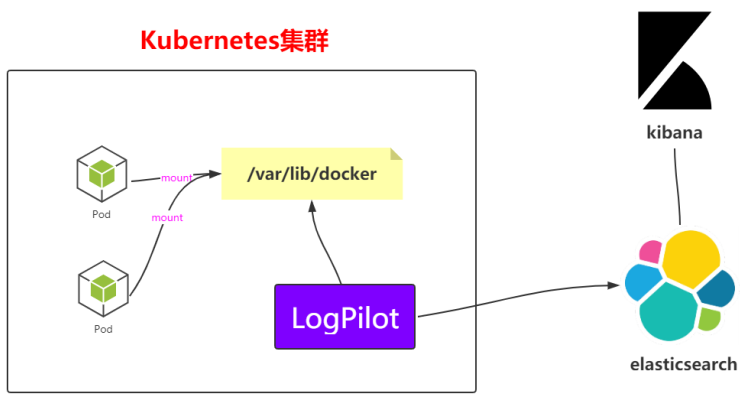
这里只是基于Kubernetes 来搭建日志的收集。不对这三个组件有过多的分析,直接干。
部署Logpilot:
(1)创建 log-pilot.yaml创建资源
kubectl apply -f log-pilot.yaml 。这里采用的是 DaemonSet 类型,是要手机所有节点的日志信息。
apiVersion: extensions/v1beta1 kind: DaemonSet metadata: name: log-pilot namespace: kube-system labels: k8s-app: log-pilot kubernetes.io/cluster-service: "true" spec: template: metadata: labels: k8s-app: log-es kubernetes.io/cluster-service: "true" version: v1.22 spec: tolerations: - key: node-role.kubernetes.io/master #可以部署到master节点上 effect: NoSchedule containers: - name: log-pilot image: registry.cn-hangzhou.aliyuncs.com/wuzz-log-monitor/log-pilot:0.9-filebeat resources: limits: memory: 200Mi requests: cpu: 100m memory: 200Mi env: - name: "FILEBEAT_OUTPUT" value: "elasticsearch" - name: "ELASTICSEARCH_HOST" value: "elasticsearch-api" - name: "ELASTICSEARCH_PORT" value: "9200" - name: "ELASTICSEARCH_USER" value: "elastic" - name: "ELASTICSEARCH_PASSWORD" value: "changeme" volumeMounts: - name: sock mountPath: /var/run/docker.sock - name: root mountPath: /host readOnly: true - name: varlib mountPath: /var/lib/filebeat - name: varlog mountPath: /var/log/filebeat securityContext: capabilities: add: - SYS_ADMIN terminationGracePeriodSeconds: 30 volumes: - name: sock hostPath: path: /var/run/docker.sock - name: root hostPath: path: / - name: varlib hostPath: path: /var/lib/filebeat type: DirectoryOrCreate - name: varlog hostPath: path: /var/log/filebeat type: DirectoryOrCreate
(2)查看pod和daemonset的信息
kubectl get pods -n kube-system -o wide | grep log
kubectl get ds -n kube-system

部署 Elasticsearch:
(1)创建elasticsearch.yaml创建资源
kubectl apply -f elasticsearch.yaml
apiVersion: v1 kind: Service metadata: name: elasticsearch-api namespace: kube-system labels: name: elasticsearch spec: selector: app: es ports: - name: transport port: 9200 protocol: TCP --- apiVersion: v1 kind: Service metadata: name: elasticsearch-discovery namespace: kube-system labels: name: elasticsearch spec: selector: app: es ports: - name: transport port: 9300 protocol: TCP --- apiVersion: apps/v1beta1 kind: StatefulSet metadata: name: elasticsearch namespace: kube-system labels: kubernetes.io/cluster-service: "true" spec: replicas: 3 serviceName: "elasticsearch-service" selector: matchLabels: app: es template: metadata: labels: app: es spec: tolerations: - effect: NoSchedule key: node-role.kubernetes.io/master initContainers: - name: init-sysctl image: busybox:1.27 command: - sysctl - -w - vm.max_map_count=262144 securityContext: privileged: true containers: - name: elasticsearch image: registry.cn-hangzhou.aliyuncs.com/wuzz-log-monitor/elasticsearch:v5.5.1 ports: - containerPort: 9200 protocol: TCP - containerPort: 9300 protocol: TCP securityContext: capabilities: add: - IPC_LOCK - SYS_RESOURCE resources: limits: memory: 4000Mi requests: cpu: 100m memory: 2000Mi env: - name: "http.host" value: "0.0.0.0" - name: "network.host" value: "_eth0_" - name: "cluster.name" value: "docker-cluster" - name: "bootstrap.memory_lock" value: "false" - name: "discovery.zen.ping.unicast.hosts" value: "elasticsearch-discovery" - name: "discovery.zen.ping.unicast.hosts.resolve_timeout" value: "10s" - name: "discovery.zen.ping_timeout" value: "6s" - name: "discovery.zen.minimum_master_nodes" value: "2" - name: "discovery.zen.fd.ping_interval" value: "2s" - name: "discovery.zen.no_master_block" value: "write" - name: "gateway.expected_nodes" value: "2" - name: "gateway.expected_master_nodes" value: "1" - name: "transport.tcp.connect_timeout" value: "60s" - name: "ES_JAVA_OPTS" value: "-Xms2g -Xmx2g" livenessProbe: tcpSocket: port: transport initialDelaySeconds: 20 periodSeconds: 10 volumeMounts: - name: es-data mountPath: /data terminationGracePeriodSeconds: 30 volumes: - name: es-data hostPath: path: /es-data
kubectl get pods -n kube-system -o wide | grep ela
尴尬的是发现机器的资源不够,由于我机器的资源不够,这里创建失败,换个机器内存大的就可以了。

2)查看kube-system下的svc
kubectl get svc -n kube-system

(3)查看kube-system下的statefulset
kubectl get statefulset -n kube-system

部署kibana:
(1)创建 kibana.yaml创建资源
kibana主要是对外提供访问的,所以这边需要配置Service和Ingress
前提:要有Ingress Controller的支持,比如Nginx Controller
# Deployment apiVersion: apps/v1beta1 kind: Deployment metadata: name: kibana namespace: kube-system labels: component: kibana spec: replicas: 1 selector: matchLabels: component: kibana template: metadata: labels: component: kibana spec: containers: - name: kibana image: registry.cn-hangzhou.aliyuncs.com/wuzz-log-monitor/kibana:v5.5.1 env: - name: CLUSTER_NAME value: docker-cluster - name: ELASTICSEARCH_URL value: http://elasticsearch-api:9200/ resources: limits: cpu: 1000m requests: cpu: 100m ports: - containerPort: 5601 name: http --- # Service apiVersion: v1 kind: Service metadata: name: kibana namespace: kube-system labels: component: kibana spec: selector: component: kibana ports: - name: http port: 80 targetPort: http --- # Ingress apiVersion: extensions/v1beta1 kind: Ingress metadata: name: kibana namespace: kube-system spec: rules: - host: kibana.wuzz.com http: paths: - path: / backend: serviceName: kibana servicePort: 80
(2)查看pod和deployment的信息
kubectl get pods -n kube-system | grep ki
kubectl get deploy -n kube-system
(3)配置Ingress需要的域名.打开windows上的hosts文件
# 注意这边是worker01的IP
192.168.1.102 kibana.wuzz.com
(4)在windows访问kibana.wuzz.com

Monitor:
Prometheus简介:https://prometheus.io/
我们知道zabbix在监控界占有不可撼动的地位,功能强大。但是对容器监控显得力不从心。为解决监控容器的问题,引入了prometheus技术。prometheus号称是下一代监控。prometheus是由谷歌研发的一款开源的监控软件,目前已经被云计算本地基金会(CNCF)托管,是继k8s托管的第二个项目。
- 易于管理,易集成,可扩展,支持自动发现
- 轻易获取服务内部状态
- 高效灵活的查询语句
- 支持本地和远程存储
- 采用http协议,默认pull模式拉取数据,也可以通过中间网关push数据
Prometheus架构:
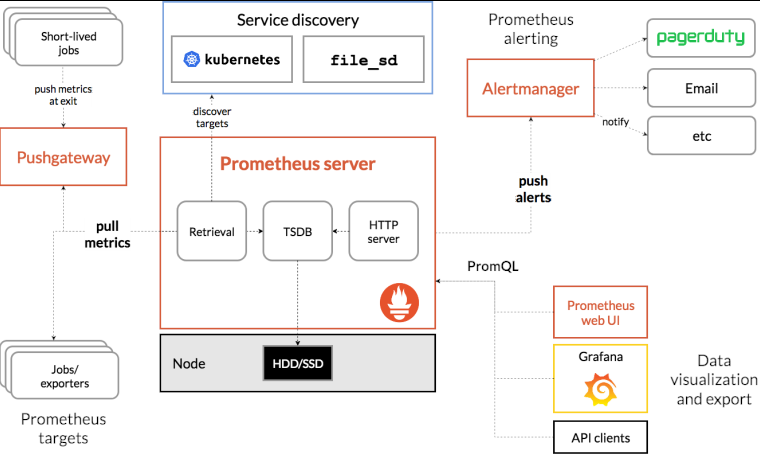
prometheus根据配置定时去拉取各个节点的数据,默认使用的拉取方式是pull,也可以使用pushgateway提供的push方式获取各个监控节点的数据。将获取到的数据存入TSDB,一款时序型数据库。此时prometheus已经获取到了监控数据,可以使用内置的PromQL进行查询。它的报警功能使用Alertmanager提供,Alertmanager是prometheus的告警管理和发送报警的一个组件。prometheus原生的图标功能过于简单,可将prometheus数据接入grafana,由grafana进行统一管理
要想监控K8s集群,那么我需要从3个维度去获取数据服务器 节点数据,组件数据,容器数据。
服务器数据:通过NodeExporter:https://github.com/prometheus/node_exporter

组件数据:组件数据由K8s提供的Rest 接口进行获取
- ETCD:https://ip:2379/metrics
- APIServer:https://ip:6443/metrics
- ControllerManager:https://ip:10252/metrics
- Scheduler:https://ip:10251/metrics
容器数据:通过cAdvisor,cadvisor是一个谷歌开发的容器监控工具,它被内嵌到k8s中作为k8s的监控组件。
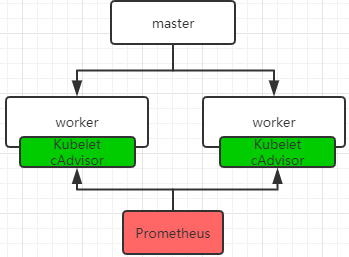
Prometheus+Grafana :
(1)创建命名空间ns-monitor。创建namespaces.yaml 文件
kubectl apply -f namespace.yaml
kubectl get namespace
apiVersion: v1 kind: Namespace metadata: name: ns-monitor labels: name: ns-monitor
(2)创建node-exporter 。创建node-exporter.yaml文件:
kind: DaemonSet apiVersion: apps/v1beta2 metadata: labels: app: node-exporter name: node-exporter namespace: ns-monitor spec: revisionHistoryLimit: 10 selector: matchLabels: app: node-exporter template: metadata: labels: app: node-exporter spec: containers: - name: node-exporter image: prom/node-exporter:v0.16.0 ports: - containerPort: 9100 protocol: TCP name: http hostNetwork: true hostPID: true tolerations: - effect: NoSchedule operator: Exists --- kind: Service apiVersion: v1 metadata: labels: app: node-exporter name: node-exporter-service namespace: ns-monitor spec: ports: - name: http port: 9100 nodePort: 31672 protocol: TCP type: NodePort selector: app: node-exporter
这里的额Service仅用域检测该服务是否已经启动。也可以不创建。
kubectl apply -f node-exporter.yaml
kubectl get pod -n ns-monitor
kubectl get svc -n ns-monitor
kubectl get ds -n ns-monitor
win浏览器访问集群任意一个ip,比如http://192.168.1.101:31672 查看结果 # 这边是http协议,不能用https
(3)部署prometheus pod 包含rbac认证、ConfigMap等.创建prometheus.yaml文件
注意 :记得修改prometheus.yaml文件中的ip为master的ip和path[PV需要使用到].另一方面,如果采用远程服务器进行持久化需要简历对应的文件夹。我这里采用NFS。记得先安装NFS
--- apiVersion: rbac.authorization.k8s.io/v1beta1 kind: ClusterRole metadata: name: prometheus rules: - apiGroups: [""] # "" indicates the core API group resources: - nodes - nodes/proxy - services - endpoints - pods verbs: - get - watch - list - apiGroups: - extensions resources: - ingresses verbs: - get - watch - list - nonResourceURLs: ["/metrics"] verbs: - get --- apiVersion: v1 kind: ServiceAccount metadata: name: prometheus namespace: ns-monitor labels: app: prometheus --- apiVersion: rbac.authorization.k8s.io/v1beta1 kind: ClusterRoleBinding metadata: name: prometheus subjects: - kind: ServiceAccount name: prometheus namespace: ns-monitor roleRef: kind: ClusterRole name: prometheus apiGroup: rbac.authorization.k8s.io --- apiVersion: v1 kind: ConfigMap metadata: name: prometheus-conf namespace: ns-monitor labels: app: prometheus data: prometheus.yml: |- # my global config global: scrape_interval: 15s # Set the scrape interval to every 15 seconds. Default is every 1 minute. evaluation_interval: 15s # Evaluate rules every 15 seconds. The default is every 1 minute. # scrape_timeout is set to the global default (10s). # Alertmanager configuration alerting: alertmanagers: - static_configs: - targets: # - alertmanager:9093 # Load rules once and periodically evaluate them according to the global 'evaluation_interval'. rule_files: # - "first_rules.yml" # - "second_rules.yml" # A scrape configuration containing exactly one endpoint to scrape: # Here it's Prometheus itself. scrape_configs: # The job name is added as a label `job=<job_name>` to any timeseries scraped from this config. - job_name: 'prometheus' # metrics_path defaults to '/metrics' # scheme defaults to 'http'. static_configs: - targets: ['localhost:9090'] - job_name: 'grafana' static_configs: - targets: - 'grafana-service.ns-monitor:3000' - job_name: 'kubernetes-apiservers' kubernetes_sd_configs: - role: endpoints # Default to scraping over https. If required, just disable this or change to # `http`. scheme: https # This TLS & bearer token file config is used to connect to the actual scrape # endpoints for cluster components. This is separate to discovery auth # configuration because discovery & scraping are two separate concerns in # Prometheus. The discovery auth config is automatic if Prometheus runs inside # the cluster. Otherwise, more config options have to be provided within the # <kubernetes_sd_config>. tls_config: ca_file: /var/run/secrets/kubernetes.io/serviceaccount/ca.crt # If your node certificates are self-signed or use a different CA to the # master CA, then disable certificate verification below. Note that # certificate verification is an integral part of a secure infrastructure # so this should only be disabled in a controlled environment. You can # disable certificate verification by uncommenting the line below. # # insecure_skip_verify: true bearer_token_file: /var/run/secrets/kubernetes.io/serviceaccount/token # Keep only the default/kubernetes service endpoints for the https port. This # will add targets for each API server which Kubernetes adds an endpoint to # the default/kubernetes service. relabel_configs: - source_labels: [__meta_kubernetes_namespace, __meta_kubernetes_service_name, __meta_kubernetes_endpoint_port_name] action: keep regex: default;kubernetes;https # Scrape config for nodes (kubelet). # # Rather than connecting directly to the node, the scrape is proxied though the # Kubernetes apiserver. This means it will work if Prometheus is running out of # cluster, or can't connect to nodes for some other reason (e.g. because of # firewalling). - job_name: 'kubernetes-nodes' # Default to scraping over https. If required, just disable this or change to # `http`. scheme: https # This TLS & bearer token file config is used to connect to the actual scrape # endpoints for cluster components. This is separate to discovery auth # configuration because discovery & scraping are two separate concerns in # Prometheus. The discovery auth config is automatic if Prometheus runs inside # the cluster. Otherwise, more config options have to be provided within the # <kubernetes_sd_config>. tls_config: ca_file: /var/run/secrets/kubernetes.io/serviceaccount/ca.crt bearer_token_file: /var/run/secrets/kubernetes.io/serviceaccount/token kubernetes_sd_configs: - role: node relabel_configs: - action: labelmap regex: __meta_kubernetes_node_label_(.+) - target_label: __address__ replacement: kubernetes.default.svc:443 - source_labels: [__meta_kubernetes_node_name] regex: (.+) target_label: __metrics_path__ replacement: /api/v1/nodes/${1}/proxy/metrics # Scrape config for Kubelet cAdvisor. # # This is required for Kubernetes 1.7.3 and later, where cAdvisor metrics # (those whose names begin with 'container_') have been removed from the # Kubelet metrics endpoint. This job scrapes the cAdvisor endpoint to # retrieve those metrics. # # In Kubernetes 1.7.0-1.7.2, these metrics are only exposed on the cAdvisor # HTTP endpoint; use "replacement: /api/v1/nodes/${1}:4194/proxy/metrics" # in that case (and ensure cAdvisor's HTTP server hasn't been disabled with # the --cadvisor-port=0 Kubelet flag). # # This job is not necessary and should be removed in Kubernetes 1.6 and # earlier versions, or it will cause the metrics to be scraped twice. - job_name: 'kubernetes-cadvisor' # Default to scraping over https. If required, just disable this or change to # `http`. scheme: https # This TLS & bearer token file config is used to connect to the actual scrape # endpoints for cluster components. This is separate to discovery auth # configuration because discovery & scraping are two separate concerns in # Prometheus. The discovery auth config is automatic if Prometheus runs inside # the cluster. Otherwise, more config options have to be provided within the # <kubernetes_sd_config>. tls_config: ca_file: /var/run/secrets/kubernetes.io/serviceaccount/ca.crt bearer_token_file: /var/run/secrets/kubernetes.io/serviceaccount/token kubernetes_sd_configs: - role: node relabel_configs: - action: labelmap regex: __meta_kubernetes_node_label_(.+) - target_label: __address__ replacement: kubernetes.default.svc:443 - source_labels: [__meta_kubernetes_node_name] regex: (.+) target_label: __metrics_path__ replacement: /api/v1/nodes/${1}/proxy/metrics/cadvisor # Scrape config for service endpoints. # # The relabeling allows the actual service scrape endpoint to be configured # via the following annotations: # # * `prometheus.io/scrape`: Only scrape services that have a value of `true` # * `prometheus.io/scheme`: If the metrics endpoint is secured then you will need # to set this to `https` & most likely set the `tls_config` of the scrape config. # * `prometheus.io/path`: If the metrics path is not `/metrics` override this. # * `prometheus.io/port`: If the metrics are exposed on a different port to the # service then set this appropriately. - job_name: 'kubernetes-service-endpoints' kubernetes_sd_configs: - role: endpoints relabel_configs: - source_labels: [__meta_kubernetes_service_annotation_prometheus_io_scrape] action: keep regex: true - source_labels: [__meta_kubernetes_service_annotation_prometheus_io_scheme] action: replace target_label: __scheme__ regex: (https?) - source_labels: [__meta_kubernetes_service_annotation_prometheus_io_path] action: replace target_label: __metrics_path__ regex: (.+) - source_labels: [__address__, __meta_kubernetes_service_annotation_prometheus_io_port] action: replace target_label: __address__ regex: ([^:]+)(?::\d+)?;(\d+) replacement: $1:$2 - action: labelmap regex: __meta_kubernetes_service_label_(.+) - source_labels: [__meta_kubernetes_namespace] action: replace target_label: kubernetes_namespace - source_labels: [__meta_kubernetes_service_name] action: replace target_label: kubernetes_name # Example scrape config for probing services via the Blackbox Exporter. # # The relabeling allows the actual service scrape endpoint to be configured # via the following annotations: # # * `prometheus.io/probe`: Only probe services that have a value of `true` - job_name: 'kubernetes-services' metrics_path: /probe params: module: [http_2xx] kubernetes_sd_configs: - role: service relabel_configs: - source_labels: [__meta_kubernetes_service_annotation_prometheus_io_probe] action: keep regex: true - source_labels: [__address__] target_label: __param_target - target_label: __address__ replacement: blackbox-exporter.example.com:9115 - source_labels: [__param_target] target_label: instance - action: labelmap regex: __meta_kubernetes_service_label_(.+) - source_labels: [__meta_kubernetes_namespace] target_label: kubernetes_namespace - source_labels: [__meta_kubernetes_service_name] target_label: kubernetes_name # Example scrape config for probing ingresses via the Blackbox Exporter. # # The relabeling allows the actual ingress scrape endpoint to be configured # via the following annotations: # # * `prometheus.io/probe`: Only probe services that have a value of `true` - job_name: 'kubernetes-ingresses' metrics_path: /probe params: module: [http_2xx] kubernetes_sd_configs: - role: ingress relabel_configs: - source_labels: [__meta_kubernetes_ingress_annotation_prometheus_io_probe] action: keep regex: true - source_labels: [__meta_kubernetes_ingress_scheme,__address__,__meta_kubernetes_ingress_path] regex: (.+);(.+);(.+) replacement: ${1}://${2}${3} target_label: __param_target - target_label: __address__ replacement: blackbox-exporter.example.com:9115 - source_labels: [__param_target] target_label: instance - action: labelmap regex: __meta_kubernetes_ingress_label_(.+) - source_labels: [__meta_kubernetes_namespace] target_label: kubernetes_namespace - source_labels: [__meta_kubernetes_ingress_name] target_label: kubernetes_name # Example scrape config for pods # # The relabeling allows the actual pod scrape endpoint to be configured via the # following annotations: # # * `prometheus.io/scrape`: Only scrape pods that have a value of `true` # * `prometheus.io/path`: If the metrics path is not `/metrics` override this. # * `prometheus.io/port`: Scrape the pod on the indicated port instead of the # pod's declared ports (default is a port-free target if none are declared). - job_name: 'kubernetes-pods' kubernetes_sd_configs: - role: pod relabel_configs: - source_labels: [__meta_kubernetes_pod_annotation_prometheus_io_scrape] action: keep regex: true - source_labels: [__meta_kubernetes_pod_annotation_prometheus_io_path] action: replace target_label: __metrics_path__ regex: (.+) - source_labels: [__address__, __meta_kubernetes_pod_annotation_prometheus_io_port] action: replace regex: ([^:]+)(?::\d+)?;(\d+) replacement: $1:$2 target_label: __address__ - action: labelmap regex: __meta_kubernetes_pod_label_(.+) - source_labels: [__meta_kubernetes_namespace] action: replace target_label: kubernetes_namespace - source_labels: [__meta_kubernetes_pod_name] action: replace target_label: kubernetes_pod_name --- apiVersion: v1 kind: ConfigMap metadata: name: prometheus-rules namespace: ns-monitor labels: app: prometheus data: cpu-usage.rule: | groups: - name: NodeCPUUsage rules: - alert: NodeCPUUsage expr: (100 - (avg by (instance) (irate(node_cpu{name="node-exporter",mode="idle"}[5m])) * 100)) > 75 for: 2m labels: severity: "page" annotations: summary: "{{$labels.instance}}: High CPU usage detected" description: "{{$labels.instance}}: CPU usage is above 75% (current value is: {{ $value }})" --- apiVersion: v1 kind: PersistentVolume metadata: name: "prometheus-data-pv" labels: name: prometheus-data-pv release: stable spec: capacity: storage: 5Gi accessModes: - ReadWriteOnce persistentVolumeReclaimPolicy: Recycle nfs: path: /nfs/data/prometheus server: 192.168.1.102 --- apiVersion: v1 kind: PersistentVolumeClaim metadata: name: prometheus-data-pvc namespace: ns-monitor spec: accessModes: - ReadWriteOnce resources: requests: storage: 5Gi selector: matchLabels: name: prometheus-data-pv release: stable --- kind: Deployment apiVersion: apps/v1beta2 metadata: labels: app: prometheus name: prometheus namespace: ns-monitor spec: replicas: 1 revisionHistoryLimit: 10 selector: matchLabels: app: prometheus template: metadata: labels: app: prometheus spec: serviceAccountName: prometheus securityContext: runAsUser: 0 containers: - name: prometheus image: prom/prometheus:latest imagePullPolicy: IfNotPresent volumeMounts: - mountPath: /prometheus name: prometheus-data-volume - mountPath: /etc/prometheus/prometheus.yml name: prometheus-conf-volume subPath: prometheus.yml - mountPath: /etc/prometheus/rules name: prometheus-rules-volume ports: - containerPort: 9090 protocol: TCP volumes: - name: prometheus-data-volume persistentVolumeClaim: claimName: prometheus-data-pvc - name: prometheus-conf-volume configMap: name: prometheus-conf - name: prometheus-rules-volume configMap: name: prometheus-rules tolerations: - key: node-role.kubernetes.io/master effect: NoSchedule --- kind: Service apiVersion: v1 metadata: annotations: prometheus.io/scrape: 'true' labels: app: prometheus name: prometheus-service namespace: ns-monitor spec: ports: - port: 9090 targetPort: 9090 selector: app: prometheus type: NodePort
这里的额Service仅用域检测该服务是否已经启动。也可以不创建。
kubectl apply -f prometheus.yaml
kubectl get pod -n ns-monitor
kubectl get svc -n ns-monitor
win浏览器访问集群任意一个ip:30911/graph 查看结果,比如http://121.41.10.126:30911
(4)部署grafana,创建grafana.yaml :
注意:需要修改持久话机制的IP ,建立对应的文件夹
apiVersion: v1 kind: PersistentVolume metadata: name: "grafana-data-pv" labels: name: grafana-data-pv release: stable spec: capacity: storage: 5Gi accessModes: - ReadWriteOnce persistentVolumeReclaimPolicy: Recycle nfs: path: /nfs/data/grafana server: 192.168.1.102 --- apiVersion: v1 kind: PersistentVolumeClaim metadata: name: grafana-data-pvc namespace: ns-monitor spec: accessModes: - ReadWriteOnce resources: requests: storage: 5Gi selector: matchLabels: name: grafana-data-pv release: stable --- kind: Deployment apiVersion: apps/v1beta2 metadata: labels: app: grafana name: grafana namespace: ns-monitor spec: replicas: 1 revisionHistoryLimit: 10 selector: matchLabels: app: grafana template: metadata: labels: app: grafana spec: securityContext: runAsUser: 0 containers: - name: grafana image: grafana/grafana:latest imagePullPolicy: IfNotPresent env: - name: GF_AUTH_BASIC_ENABLED value: "true" - name: GF_AUTH_ANONYMOUS_ENABLED value: "false" readinessProbe: httpGet: path: /login port: 3000 volumeMounts: - mountPath: /var/lib/grafana name: grafana-data-volume ports: - containerPort: 3000 protocol: TCP volumes: - name: grafana-data-volume persistentVolumeClaim: claimName: grafana-data-pvc --- kind: Service apiVersion: v1 metadata: labels: app: grafana name: grafana-service namespace: ns-monitor spec: ports: - port: 3000 targetPort: 3000 selector: app: grafana type: NodePort
kubectl apply -f grafana.yaml
kubectl get pod -n ns-monitor

kubectl get svc -n ns-monitor

win浏览器访问集群任意一个ip:31470/graph/login 。比如http://192.168.1.101:31470用户名密码:admin

登陆后就可以进行平常的操作了,可以设置prometheus 作为数据源:
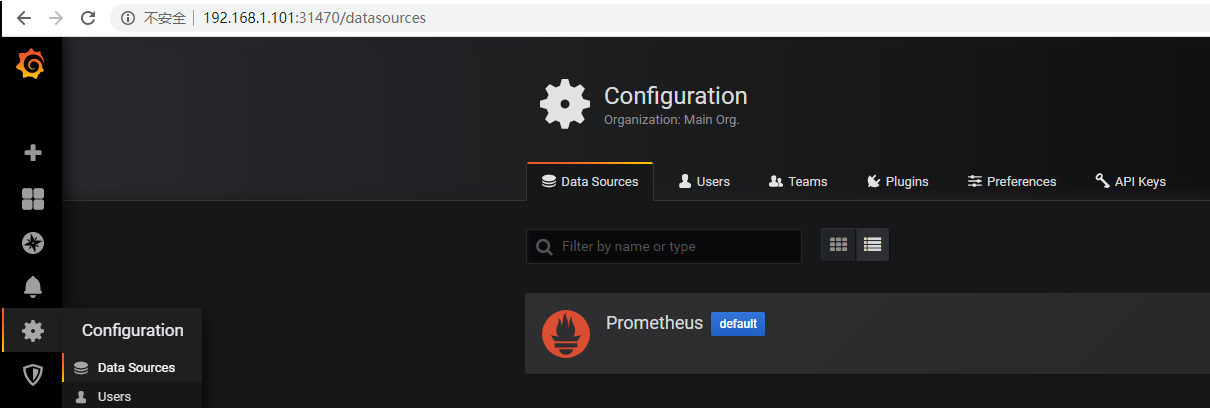
(5)增加域名访问[没有域名好像没有灵魂],创建ingress.yaml
前提 :配置好ingress controller和域名解析
#ingress apiVersion: extensions/v1beta1 kind: Ingress metadata: name: ingress namespace: ns-monitor spec: rules: - host: monitor.k8s.wuzz.com http: paths: - path: / backend: serviceName: grafana-service servicePort: 3000
kubectl apply - ingress.yaml
kubectl get ingress -n ns-monitor
kubectl describe ingress -n ns-monitor
(6)直接通过域名访问即可
Trouble Shooting(故障排除):
Master:master上的组件共同组成了控制平面
01 若apiserver出问题了会导致整个K8s集群不可以使用,因为apiserver是K8s集群的大脑
02 若etcd出问题了apiserver和etcd则无法通信,kubelet也无法更新所在node上的状态
03 当scheduler或者controller manager出现问题时会导致deploy,pod,service等无法正常运行
解决方案 :出现问题时,监听到自动重启或者搭建高可用的master集群
Worker Node:
worker节点挂掉或者上面的kubelet服务出现问题时,w上的pod则无法正常运行。
Addons(插件):
dns和网络插件比如calico发生问题时,集群内的网络无法正常通信,并且无法根据服务名称进行解析。
系统问题排查:
查看Node的状态
kubectl get nodes
kubectl describe node-name
查看集群master和worker组件的日志
journalctl -u apiserver
journalctl -u scheduler
journalctl -u kubelet
journalctl -u kube-proxy
Pod的问题排查:
K8s中最小的操作单元是Pod,最重要的操作也是Pod,其他资源的排查可以参照Pod问题的排查
(1)查看Pod运行情况
kubectl get pods -n namespace
(2)查看Pod的具体描述,定位问题
kubectl describe pod pod-name -n namespace
(3)检查Pod对应的yaml是否有误
kubectl get pod pod-name -o yaml
(4)查看Pod日志
kubectl logs ...
Pod可能会出现哪些问题及解决方案:
01 处于Pending状态 说明Pod还没有被调度到某个node上,可以describe一下详情。可能因为资源不足,端口被占用等。 02 处于Waiting/ContainerCreating状态 可能因为镜像拉取失败,或者是网络插件的问题,比如calico,或者是容器本身的问题,可以检查一下容器的yaml文件内容和Dockerfile的书写。 03 处于ImagePullBackOff状态 镜像拉取失败,可能是镜像不存在,或者没有权限拉取。 04 处于CrashLoopBackOff状态 Pod之前启动成功过,但是又失败了,不断在重启。 05 处于Error状态 有些内容不存在,比如ConfigMap,PV,没有权限等,需要创建一下。 06 处于Terminating状态 说明Pod正在停止 07 处于Unknown状态 说明K8s已经失去对Pod的管理监听。



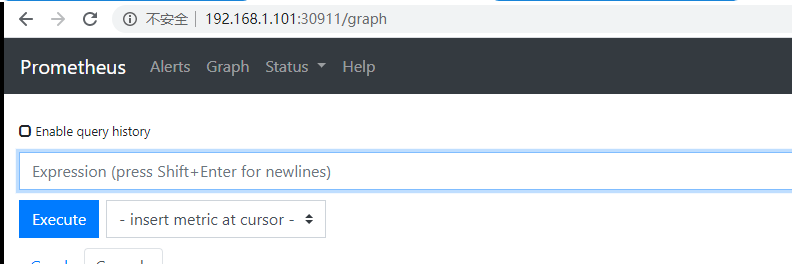

 浙公网安备 33010602011771号
浙公网安备 33010602011771号